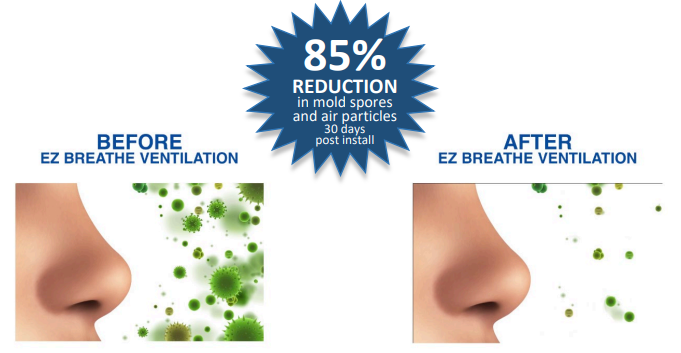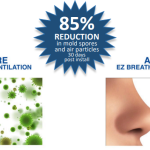Improving Indoor Air Quality: A Comprehensive Guide
Indoor air quality (IAQ) plays a critical role in our overall health and well-being. With the majority of people spending a significant portion of their lives indoors, it’s imperative that we prioritize good IAQ to ensure a healthier living environment. In this comprehensive guide to identify indoor air sources, we will explore effective strategies to improve indoor air quality and create a healthier living space.
1. Keep Your Home Clean
Keeping your home clean is a fundamental and essential step in improving environmental health and indoor air quality (IAQ). A clean home not only looks appealing but also significantly contributes to a healthier living environment. Here, we delve deeper into the importance of keeping your home clean and provide specific tips to help you maintain the cleanliness needed for better IAQ.
Why Is Keeping Your Home Clean Important for IAQ?
- Dust and Allergen Control: Dust is a common indoor pollutant, and it can contain a mixture of particles, including dirt, pollen, pet dander, and more. These particles can become airborne, leading to respiratory issues and allergies. Regular cleaning helps to remove dust and allergens, reducing the chances of exposure.
- Mold Prevention: Mold thrives in damp and dirty environments. By keeping your home clean, especially in areas prone to moisture, you can help prevent mold growth. Mold spores in the air can cause a range of health problems, particularly for individuals with allergies or respiratory conditions.
- Reduced Pest Infestations: A clean home is less attractive to pests such as cockroaches, rodents, and insects. These pests can carry allergens and spread diseases. Maintaining a clean living space minimizes the likelihood of infestations and their associated IAQ problems.
Effective Cleaning Strategies for Better IAQ
Here are some practical strategies to help you maintain a clean home and enhance IAQ:
- Regular Vacuuming: Invest in a vacuum cleaner equipped with a high-efficiency particulate air (HEPA) filter. HEPA filters trap tiny particles, preventing them from being recirculated into the air. Vacuum your floors, carpets, and upholstery regularly to minimize the accumulation of dust and allergens.
- Damp Dusting: Instead of dry dusting, use a damp cloth or microfiber cloth to clean surfaces. Dry dusting can often just disperse particles into the air, whereas damp dusting traps them, leaving surfaces cleaner and air fresher.
- Wash Bedding and Upholstery: Bedding, curtains, and upholstery can collect dust mites and allergens over time. To maintain better IAQ, wash these items regularly according to the manufacturer’s recommendations. Using hot water and an appropriate detergent can help ensure a thorough cleaning.
- Maintain a Clutter-Free Space: Clutter can make cleaning more challenging and provide hiding spots for dust and pests. By keeping your living spaces tidy and organized, you can simplify the cleaning process and reduce the chances of indoor pollutants accumulating.
- Use Natural Cleaning Products: Many conventional cleaning products contain chemicals and volatile organic compounds (VOCs) that can compromise IAQ. Consider switching to natural or low-toxicity cleaning products.
- Consider Air Purifiers: While not a cleaning method in the traditional sense, air purifiers with HEPA filters can be an excellent addition to your home. They can help capture and remove particles from the air, further enhancing IAQ.
- Regularly Clean and Maintain Appliances: Don’t forget about appliances like air conditioners, dehumidifiers, and HVAC systems. Regular maintenance, including filter replacement, is essential to ensure they operate efficiently and contribute positively to your home’s IAQ.
Incorporating these cleaning strategies into your routine not only promotes cleaner indoor air quality problems but also creates a more pleasant and comfortable living space. Remember that good IAQ is an ongoing commitment, and maintaining cleanliness in your home is a vital part of that effort. By keeping your home clean and following the other IAQ-enhancing strategies mentioned in this comprehensive guide, you’ll be on your way to enjoying a healthier and more comfortable indoor environment.
2. Control Humidity Levels
Controlling humidity levels in your home is a crucial aspect of maintaining good indoor air quality (IAQ). Humidity, the amount of moisture in the air, can have a significant impact on your living environment and the health of its occupants. In this section, we’ll delve deeper into the importance of humidity control, explain the health effects of of excess or insufficient humidity, and provide practical tips for maintaining optimal indoor humidity levels.
The Impact of Humidity on IAQ
- Mold and Mildew Growth: Excess humidity in your home can create an environment conducive to mold and mildew growth. These microorganisms release spores and mycotoxins into the air, which can lead to various health problems, including respiratory issues, allergies, and skin irritation.
- Dust Mite Proliferation: Dust mites, microscopic organisms that thrive in humid conditions, are a common indoor allergen. High humidity levels can lead to an increase in dust mite populations, worsening allergy symptoms in sensitive individuals.
- Improved Air Quality: Maintaining the right humidity levels (ideally between 30% and 50%) can help prevent the proliferation of pollutants and allergens. Balanced humidity helps to keep these indoor pollutants at bay and ensures that the air you breathe is cleaner and healthier.
Effective Strategies to Control Humidity
- Use Dehumidifiers: Dehumidifiers are appliances designed to remove excess moisture from the air. They can be particularly useful in humid climates or during the summer months when humidity levels tend to rise. Place dehumidifiers in areas prone to excess moisture, such as basements and bathrooms, and ensure they are properly sized for the space.
- Ventilation: Proper ventilation is key to controlling humidity levels. Ensure your home has adequate ventilation to allow moist air to escape and fresh outdoor air to enter. Use exhaust fans in bathrooms and kitchens to remove excess moisture and pollutants. Regularly open windows, especially when the outdoor air is less humid.
- Maintain Consistent Indoor Temperatures: Temperature can affect humidity levels. Sudden temperature fluctuations can cause condensation, leading to moisture buildup. Maintain consistent indoor temperatures to minimize this effect. Energy-efficient insulation and weather sealing can help control temperature fluctuations.
- Fix Plumbing Leaks Promptly: Leaking pipes or fixtures can introduce moisture into your home, leading to elevated humidity levels. Promptly address any plumbing issues to prevent moisture buildup and the potential for mold growth.
- Use Air Conditioners with Dehumidifying Capabilities: Many modern air conditioning systems come equipped with dehumidifying features. These systems can help maintain comfortable humidity levels while also cooling the air. Using air conditioners in humid climates can be particularly effective in humidity control.
- Monitor Humidity Levels: Invest in a hygrometer, a device that measures humidity levels in your home. Regularly check and adjust your efforts to control humidity based on the readings from the hygrometer.
- Improve Natural Ventilation: Open windows and doors strategically to facilitate natural cross-ventilation. This can help reduce humidity levels and bring in fresh air, particularly in the early morning or late evening when outdoor humidity is lower.
By diligently controlling humidity levels, you can effectively manage air contaminants and mitigate the problems associated with excess moisture in your home. This not only contributes to better indoor air quality but also promotes a more comfortable and healthier living environment for you and your family.
3. Ventilate Properly
Proper ventilation is a crucial component of maintaining good indoor air quality (IAQ) in your home. Adequate ventilation ensures that fresh outdoor air circulates throughout your living space while helping to remove indoor air pollutants and excess moisture. In this section, we’ll explore the importance of proper ventilation, and its benefits against poor air quality, and provide practical tips on how to ensure your home is well-ventilated.
The Importance of Proper Ventilation
- Removal of Indoor Pollutants: Proper ventilation helps to expel indoor pollutants, such as volatile organic compounds (VOCs), cooking odors, and other airborne contaminants. This ensures that the air you breathe is cleaner and healthier.
- Moisture Control: Ventilation is essential for controlling indoor humidity. Excessive moisture can lead to mold growth, dust mites, and other IAQ issues. Adequate ventilation helps maintain optimal humidity levels (ideally between 30% and 50%).
- Improved Air Circulation: Proper ventilation ensures even air circulation throughout your home. This helps distribute the benefits of cleaner, fresher air to all living spaces, creating a more comfortable environment.
- Preventing Stale Air: Without proper ventilation, indoor air can become stale and stuffy. Regularly introducing fresh outdoor air helps keep your living space feeling more inviting and pleasant.
Practical Tips for Effective Ventilation
- Open Windows and Doors: The simplest way to introduce fresh air into your home is to open windows and doors, especially when outdoor air quality is good and humidity levels are within the ideal range. Cross-ventilation, where air flows through your home from one side to the other, can be particularly effective.
- Use Exhaust Fans: Install exhaust fans in areas where pollutants and excess moisture are produced, such as bathrooms, kitchens, and laundry rooms. Ensure these fans are vented to the outdoors to prevent the recirculation of pollutants.
- Whole-House Ventilation Systems: Consider installing a whole-house ventilation system, which is designed to provide continuous fresh air circulation throughout your home. These systems are equipped with filters to ensure that the outdoor air introduced is clean and free from pollutants.
- Regular Maintenance: Maintain and clean your ventilation systems regularly. Filters in HVAC systems, exhaust fans, and whole-house ventilation systems should be cleaned or replaced as needed to ensure they function effectively.
- Control Indoor Air Quality: Keep an eye on indoor air quality and adjust your ventilation strategies accordingly. For instance, if you’ve used cleaning products that may introduce pollutants, proper ventilation can help disperse these indoor chemicals.
By adopting these ventilation strategies, you can effectively ensure that your home benefits from proper air exchange and circulation. This not only less air pollution and contributes to better IAQ but also creates a more inviting and comfortable living environment. Remember that adequate ventilation is an ongoing process, and regular maintenance and adjustments are essential to maintaining a healthy indoor atmosphere.
Testing for radon and carbon monoxide is a critical aspect of maintaining acceptable indoor air quality, (IAQ) and ensuring the safety of your home and its occupants. Both radon and carbon monoxide are colorless, odorless gases that can pose serious health risks. In this section, we will explore the importance of testing for these gases, their sources, and how to protect your home from their potential dangers.
The Importance of Testing for Radon and Carbon Monoxide
1. Radon Testing:
- Health Risks: Radon is a naturally occurring radioactive gas that seeps into homes through the ground. Testing for radon is crucial to detect and mitigate this invisible threat.
- Protecting Your Family: By testing for radon, you can identify if your home has elevated levels and take steps to reduce its concentration. Radon mitigation measures, such as sealing foundation cracks and installing radon mitigation systems, can effectively reduce radon levels in your home.
2. Carbon Monoxide Testing:
- Health Risks: Carbon monoxide (CO) is produced by the incomplete combustion of fuels like natural gas, propane, and wood. It can be emitted by gas appliances, heating systems, and generators. CO is poisonous and can cause symptoms such as headache, dizziness, nausea, and, in extreme cases, can be fatal.
- Safety and Prevention: Carbon monoxide detectors are essential in homes with fuel-burning appliances and heating systems. Regular testing ensures that these detectors are in working order and can provide an early warning in the event of a CO leak. A malfunctioning or outdated detector may fail to alert you to the presence of this dangerous gas.
Testing for Radon
- Radon Testing Kits: Radon testing kits are available at most hardware stores or online. These kits typically include a radon detector or a set of detectors. You place these detectors in your home for a specified period, usually a few days to a week, in areas commonly occupied, like the basement and living areas.
- Professional Radon Testing: You can also hire a professional radon testing service to conduct a more comprehensive assessment of radon levels in your home. They may use continuous monitoring devices, which can provide more accurate and real-time data.
- Interpreting Results: Once you’ve completed testing, follow the instructions provided with your testing kit to interpret the results. If radon levels are elevated, it’s essential to take action to reduce radon concentrations in your home.
Testing for Carbon Monoxide
- Carbon Monoxide Detectors: Install carbon monoxide detectors on every level of your home, particularly near bedrooms and common living areas. Follow the manufacturer’s instructions for proper placement and maintenance. Test the detectors regularly to ensure they are functioning correctly.
- Professional Inspection: It’s a good idea to have a professional inspect and service your fuel-burning appliances, heating systems, and chimneys regularly. They can ensure that these systems are functioning safely and not emitting harmful levels of carbon monoxide.
- Responding to Alarms: If a carbon monoxide alarm goes off, evacuate your home immediately and contact your local emergency services. Do not re-enter the home until it has been inspected, and the source of the carbon monoxide leak has been addressed.
Testing for radon and carbon monoxide is an essential step in creating a safe and healthy indoor environment. By regularly checking for these invisible threats found in homes, and taking appropriate measures to mitigate them, you can protect your family’s health and well-being and ensure that your home remains a safe haven.
Improving indoor air quality is vital for creating a healthy and comfortable living environment. By following these strategies, including keeping your home clean, controlling humidity levels, proper ventilation, avoiding indoor smoking, using natural cleaning products, incorporating indoor plants, and testing for radon and carbon monoxide, you can significantly reduce indoor air pollutants and enhance IAQ. Prioritizing these measures will help safeguard your health and well-being, ensuring that you and your loved ones breathe clean and fresh air indoors. Remember, a healthier indoor environment leads to a healthier life.
If you need professional assistance in improving your indoor or outdoor air pollution quality, consider contacting the experts at EZ Breathe at 866-822-7328.







